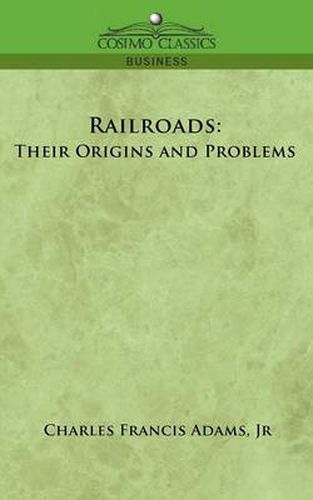Readings Newsletter
Become a Readings Member to make your shopping experience even easier.
Sign in or sign up for free!
You’re not far away from qualifying for FREE standard shipping within Australia
You’ve qualified for FREE standard shipping within Australia
The cart is loading…






This title is printed to order. This book may have been self-published. If so, we cannot guarantee the quality of the content. In the main most books will have gone through the editing process however some may not. We therefore suggest that you be aware of this before ordering this book. If in doubt check either the author or publisher’s details as we are unable to accept any returns unless they are faulty. Please contact us if you have any questions.
Competition made the price of flour and cloth and shoes equal and reasonable; why should it make fares and freights unequal and unreasonable? Few indeed were they who could be made to see that the true cause of complaint was with an economical theory misapplied… The system was, indeed, fairly honeycombed with jobbery and corruption. -from The Railroad Problem In the middle to late 19th century, a morass of civic and social concerns ensnared private corporations-the railroads-that provided what was essentially a public service. The railroad problem was only beginning to dramatically impact the United States when, in 1878, Charles Francis Adams, Jr., an expert on railroad management and the future president of the Union Pacific Railroad wrote Railroads: Their Origin and Problems. Through an exploration of the state of the industry in the U.S., Great Britain, and Europe, Adams examines issues of free trade, corporate power, government support of a public utility, and even social engineering: how do technology and the government’s power to tax and subsidize shape society? The great railroads of the 19th century may have passed into history, but the issues they raised continue to concern us today. American businessman CHARLES FRANCIS ADAMS, JR. (1835-1915), the grandson of John Quincy Adams, was educated at Harvard and served in the Union Army during the Civil War, achieving the rank of brigadier general.
$9.00 standard shipping within Australia
FREE standard shipping within Australia for orders over $100.00
Express & International shipping calculated at checkout
This title is printed to order. This book may have been self-published. If so, we cannot guarantee the quality of the content. In the main most books will have gone through the editing process however some may not. We therefore suggest that you be aware of this before ordering this book. If in doubt check either the author or publisher’s details as we are unable to accept any returns unless they are faulty. Please contact us if you have any questions.
Competition made the price of flour and cloth and shoes equal and reasonable; why should it make fares and freights unequal and unreasonable? Few indeed were they who could be made to see that the true cause of complaint was with an economical theory misapplied… The system was, indeed, fairly honeycombed with jobbery and corruption. -from The Railroad Problem In the middle to late 19th century, a morass of civic and social concerns ensnared private corporations-the railroads-that provided what was essentially a public service. The railroad problem was only beginning to dramatically impact the United States when, in 1878, Charles Francis Adams, Jr., an expert on railroad management and the future president of the Union Pacific Railroad wrote Railroads: Their Origin and Problems. Through an exploration of the state of the industry in the U.S., Great Britain, and Europe, Adams examines issues of free trade, corporate power, government support of a public utility, and even social engineering: how do technology and the government’s power to tax and subsidize shape society? The great railroads of the 19th century may have passed into history, but the issues they raised continue to concern us today. American businessman CHARLES FRANCIS ADAMS, JR. (1835-1915), the grandson of John Quincy Adams, was educated at Harvard and served in the Union Army during the Civil War, achieving the rank of brigadier general.